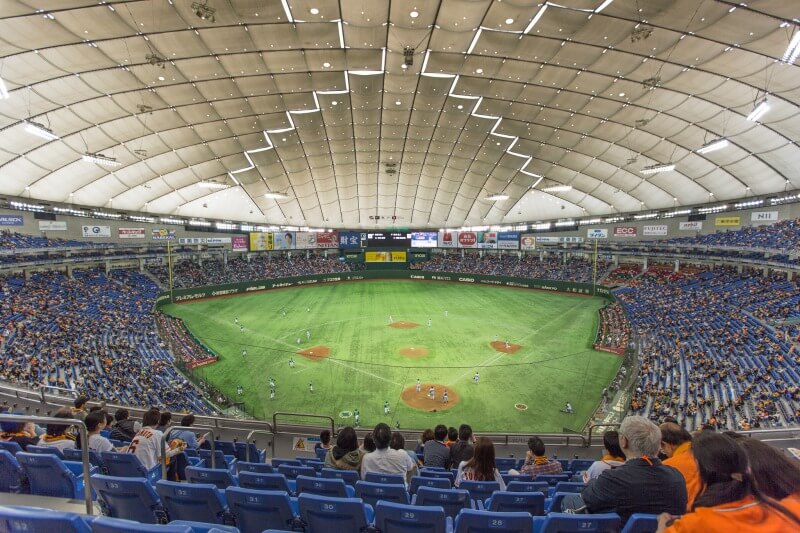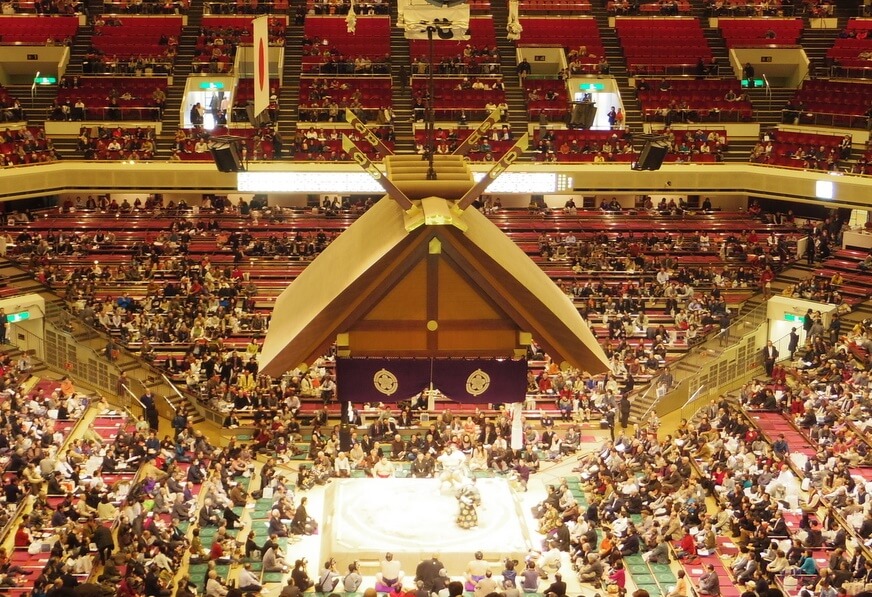Tokyo has one of the most extensive train systems in the whole world, with several multiple station making the list of ‘world’s busiest train stations’. Train transportation in Tokyo refers to JR (Japan Railway) lines, Tokyo Metro, Toei Subway, and other railway companies that operate in and around the metropolitan area. The Chuo Line is one of the major rail lines in Tokyo operated by JR East, consisting of two types of trains: the yellow ‘local’ line and the orange ‘rapid’ train. The line is operated by JR East, which means you can use your JR Rail Pass on this train line!
The Chuo Line is part of a train line operating all the way from Tokyo to Nagoya. In this article however, we will focus on the most relevant section between Takao Station (west) and Ryogoku (east). The 53.1 km rail line is one of the best-connected lines in the city, with 24 stations that each function as a gateway to a number of tourist attractions around the city. In this article, we will take you to the highlights that you can find along Chuo Line, crossing Tokyo from west to east!
- 1. Ghibli Museum (Mitaka St.)
- 2. Inokashira Park (Kichijoji St.)
- 3. Otaku Culture in Nakano (Nakano St.)
- 4. Shinjuku Gyoen (Shinjuku St.)
- 5. Meiji Jingu (Yoyogi St.)
- 6. Yasukuni Shrine (Ichigaya st.)
- 7. Tokyo Dome (Suidobashi St./ Iidabashi St.)
- 8. Kanda Myojin (Ochanomizu St.)
- 9. The home of Sumo (Ryogoku St.)
- Japan Wonder Travel Tours & Tickets
- Other articles you might like
1. Ghibli Museum (Mitaka St.)
Ghibli Museum is the famous animation art museum, popular among both international and domestic travellers since its opening in 2001. It houses a large collection of exhibits and works by “Studio Ghibli”, the world-famous Japanese animation studio with countless numbers of fans around the world. At the entrance, you are welcomed by Totoro, one of the more adorable famous Ghibli characters! All the buildings have a beautiful and fantastic design, that reminds you of the landscapes in Ghibli movies. There are several buildings displaying impressive exhibits which help you to understand how the great Ghibli movies are produced. They also have original products perfect as a souvenir. An online reservation is required for all visitors in advance, and you can’t enter the museum without it. It is definitely a must-visit spot for Ghibli fans!

Ghibli museum opening hours 10am – 6pm *closed on Tuesday
Ghibli museum admission fee ¥1,000 (adults),
2. Inokashira Park (Kichijoji St.)
Inokashira Park is a beautiful park located between Musashino and Mitaka city. The park was opened in 1917, and is visited by a number of people all year round, but especially in spring. One of it popular attraction points is Inokashira Pond, and the surrounding area with colorful seasonal flowers and the two zoo’s. In the Edo period, Inokashira Pond was used as a water source of Kanda Aqueduct which was constructed to supply drinkwater for people living in the area. There are remarkable historical spots such as Inokashira Benzaiten, a Buddhist temple on a small island in the pond.

3. Otaku Culture in Nakano (Nakano St.)
Nakano is another otaku heaven for the anime and gaming fans. It is most famous for Nakano Broadway, a large shopping complex named after the famous Broadway in New York City. At Nakano Broadway you can find many shops selling new and second-hand products related to anime, manga, video games and idols. Even if you are not a big anime or otaku fan, Nakano Broadway will be a fun experience and also great for shopping some unique, extraordinary souvenirs.

Next to the anime related stores, Nakano also offers relaxing parks, historical temples and shrines. For example the and much more. For example the Hikawa Shrine, a sacred Shinto shrine located between Koenji Station and Nakano Station. Although the details of the shrine remain unclear, this historical spot is visited by an large number of visitors. The original shrine was destroyed by fire during WWⅡ, but reconstructed later. It enshrines the God of weather, and has been getting more popular by students who wish to pass the national examination required to become a professional weather forecaster in Japan!
4. Shinjuku Gyoen (Shinjuku St.)
Shinjuku Station is the world’s busiest train station and when visiting Tokyo, you will most likely find yourself here once. The area is home to a large number of tourist attractions, including some of the most vibrant drinking spots like the famous Golden Gai. Another place you should not miss out on is Shinjuku Gyoen, a beautiful, large park and garden. During the Edo period, it was used as the private residence for Naito family who dominated the Shinano area (currently part of Nagano prefecture). It was later transformed into an imperial garden under the control of the Imperial Household Agency in 1906, and was finally opened to the public as a national garden in 1949. It boasts a large variety of seasonal flowers and beautiful plants all year around, but Spring is the most popular timing. During the spring season, large crowds of people flock to the park to admire the beautiful cherry blossoms. It also has three different types of gardens including traditional Japanese style, French formal style, and English landscape style with unique features.

Shinjuku Gyoen
9am – 4pm Oct. 1st – Mar. 14
9am – 5.30pm Mar. 15 – Jun. 30 & Aug. 21 – Sep. 30
9am – 6.30pm Jul. 1st – Aug. 20
*closed on Monday
Admission ¥500
5. Meiji Jingu (Yoyogi St.)
Meiji Jingu (also known as Meiji Shrine) is an old Shinto shrine established in 1920. It is dedicated to the Emperor Meiji and his wife, and one of the most visited shrine in Japan on New Year’s Day with over 3 million visitors every year. The shrine complex covers a large area and serves as an oasis of calm with beautiful nature, in the heart of Tokyo city just a stone’s throw away from Shibuya crossing. It also has a beautiful Japanese-style garden called Meiji Shrine Imperial Garden. From Yoyogi station, walk the sacred approach leading to the main shrine and feel the power of nature and discover several spiritual spots! When you’re in luck, you might spot a traditional wedding ceremony at this shrine too.
A visit to Meiji Jingu is easily combined with a visit to another major hotspot of Tokyo: Takeshita street in Harajuku. This area is also known as the centre of the Japanese kawaii pop culture and a must-visit place. Wander around in the alleys of Harajuku and Omotesando, known for its many (second-hand) fashion shops.
Meiji Jingu opens with sunrise and closes at sunset.
6. Yasukuni Shrine (Ichigaya st.)
Yasukuni Shrine, located between Ichigaya Station and Iidabashi Station is a large shinto shrine commemorating Japan’s war dead who served the Japanese emperor. In total 2.5 million people who died in war for their country are enshrined at Yasukuni. The shrine is somewhat controversial as it enshrines some war dead who actually were classified as class A war criminals. On the shrine grounds stand also a large number of sakura trees.

7. Tokyo Dome (Suidobashi St./ Iidabashi St.)
Tokyo Dome is a symbolic baseball stadium located near Suidobashi Station and Iidabashi Station, both on the Chuo Line. It is the home field of the Yomiuri Giants, one of the most popular baseball teams in Japan. With a capacity of up to 55,000, it is also occasionally used for big music concerts or other sports events. As inside the dome is air-conditioned all the time, you can enjoy watching the baseball games comfortably even in the hot Japanese summer. Tokyo Dome City is a multi-functional facility including an exciting amusement park, luxurious hotels and a shopping mall with a number of restaurants. It offers a range of entertainments and enjoyable experiences for the whole family.


8. Kanda Myojin (Ochanomizu St.)
Kanda Myojin is a shrine that was established already in 730 and known as the oldest shrine in Tokyo. It is located north of Ochanomizu station. Ochanomizu area is popular for its many guitar and instrument shops and located within walking distance from the the buzzing district of Akihabara. During the Edo period, the Kanda Myojin shrine served as an important shrine which was strongly associated with the Tokugawa Shogunate who ruled the entire country with for over 260 years. In May, Kanda Myojin hosts Kanda Matsuri, one of the three biggest Shinto festivals in Tokyo. It is held every two years, and attracts large crowds of people with a variety of exciting events. Combine your visit to the shrine with the Akihabara area, a unique area full of electric shops selling cool gadgets, and also known as a pop-culture center such as Anime and Manga.

9. The home of Sumo (Ryogoku St.)
Ryogoku is a city of Japanese tradition and history, with many reminders of the Edo era. The city is known as the sumo capital of Japan because the area is home to Ryogoku Kokugikan, the most famous sumo stadium where three of the six annual sumo tournaments are held. If you happen to be in Tokyo during one of these twee week events (held three times a year in Tokyo in January, May, and September), then a visit to the Grand Sumo Tournament is a must. We recommend you to try to get tickets to the tournament early as it is a popular activity also for the Japanese. Watching a game of sumo is a great experience to witness some impressive parts of the Japanese culture. Alternatively, you can also visit a sumo stable in Ryogoku, and watch the sumo wrestlers get ready for the tournament. The majority of the sumo stables are also located in Ryogoku.
Get your sumo tickets for the Grand Sumo Tournament (Contact us)
Japan Wonder Travel Tours & Tickets
If you need some help to organize your trip to Japan, you should definitely check out our private tour with local, English-speaking guides. We’d be happy to help you make your trip to Japan a safe, comfortable, and unforgettable memory!
1. Get Tickets of the Ghibli Museum (Contact us)
Tickets to the Ghibli Museum are exceptionally difficult to get and need to be reserved a long time in advance. Let us help you get tickets of the Ghibli Museum with a special early-bird discount!
2. Tokyo 1–Day Highlights Private Walking Tour
To make most out of your experience, join a guided tour in Tokyo. Explore the highlights in Tokyo and discover the city from a local’s perspective.

Following the Chuo Line is a comfortable way of exploring some Tokyo’s many amazing sights. The Chuo line is the only line crossing the popular Yamanote loop, from east to west. Explore the nightlife in Shinjuku, the historical Meiji Shrine near Yoyogi Station or some sumo action in Ryogoku. is one of the top sights in the city. The Imperial Palace near Tokyo Station and the controversial Yasukuni Shrine are all within easy reach for anyone wanting to see Tokyo’s culture. Any of the tourist attractions introduced above can be a perfect destination for a day trip or having a relaxing time on weekends. Take Chuo Line and find your favorite tourist attraction!
Follow us on Instagram or Facebook for more travel inspiration. Or tag us to get featured!
Happy travelling!
Other articles you might like

This post may contain some affiliate links. When you click through and make a purchase we may receive some commission, at no extra costs to you.










